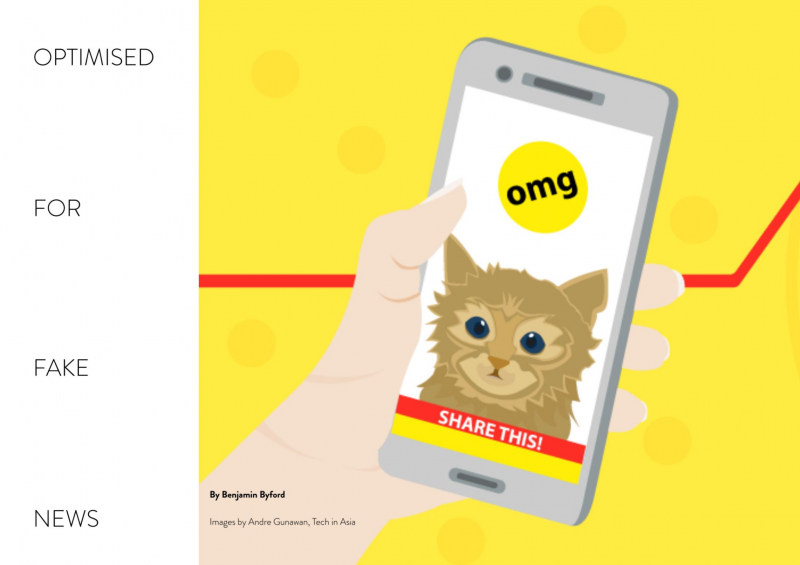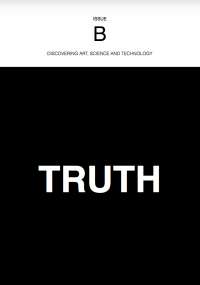Optimised for Fake News
Play audio recording
Published: 08 Sep 2017
Optimised for Fake News written for THECUBE Magazine TRUTH issue by Ben Byford. Direct download (pdf)
Fake news, in this instance, is a recent term coined to explain misleading or wholly fabricated website articles. The articles are shared on social media to garner misdirection or mistrust for the article’s subject. They can be political, but always are they just teetering beyond a line of plausibility. However for the article, theses websites are mostly created to leverage clicks to generate income based on lies dressed up as truths.

In 1994 advertising online went mainstream; Pandora’s Box opened. Previously, the ARPANET begot the Internet and on top the World Wide Web was conceived - a set of technologies for accessing and displaying scientific documents. Or that was it’s original purpose. The World Wide Web, more commonly known now as simply: the web, was host to message boards, links to digital chat rooms, counter-cultures of all kinds; a new type of freedom privileged by those who had limited access, yet created openly for everyone. During the early nineties industry got onboard with the both the Internet and the Web, turning a limited resource into a paid-for abundance. The Dotcom Bubble companies came of age after online advertising had been established leaving them to grapple with new kinds of financial models. However, many revenue streams fell to the wayside leaving mostly Ad supported models for most.
Away from commercial interests, some new websites were being made in the spirit of the Web. I can remember being told not to use references from Wikipedia in my essays during my education. But what to use then? I had just been given access to a Pantheon of information on the Web and was told it can’t be trusted. The peer-review process the scientific community hinges on grew an unwanted child on the Web: the Wiki. Like open-source software, many hands (and eyes) make light work. Many many eyes, make software, who have created the most used operating systems, web servers and browsers; and who continue to compile summaries and references to the worlds knowledge cross-referenced and reviewed. This was happening openly and free for the interests of society, or those with internet connections.
At the same time children were growing up with the Web of abundant communication, with instant messaging, instant shopping and instant knowledge. From MSN Messenger to Snapchat a whole generation was becoming comfortable with technology as consumption and consuming more and more. Today we read news, updates from friends, create videos, and post our own truths. We are all creators, content producers and consumers, continuously paying an unadvertised price through our habits, words, clicks and ultimately our wallets. We are linking, sharing and liking without a second glance, opinion, critique. Coming of age with the Web of today we are blind to our footprint and ignorant to our news sources.
 While the Web was becoming social, adverts were being democratised. Anyone could add Google Adwords to their site and earn big by driving more and more traffic to that site. Predictably, sites morphed or were created with this in mind. Websites like the Mail Online, Buzzfeed and others lead to the coining of the term clickbait: eye-catching, candy-coated persuasive headlines designed to entice us the data excreter, the creator, the shoppers to click. Those clicks take us beyond in a flash to the land of smart banner ads fuelling content created for our sensation, to entertain, to entrap. However, billboard ads on the Web were just as static, and untargeted as roadside adsand users started to get wise.
While the Web was becoming social, adverts were being democratised. Anyone could add Google Adwords to their site and earn big by driving more and more traffic to that site. Predictably, sites morphed or were created with this in mind. Websites like the Mail Online, Buzzfeed and others lead to the coining of the term clickbait: eye-catching, candy-coated persuasive headlines designed to entice us the data excreter, the creator, the shoppers to click. Those clicks take us beyond in a flash to the land of smart banner ads fuelling content created for our sensation, to entertain, to entrap. However, billboard ads on the Web were just as static, and untargeted as roadside adsand users started to get wise.
Many websites (or indeed services as they started to transcend mere information portals) in the post commerce Web were relying more and more on advertising as their only stream of revenue; online billboards had taken over but they weren’t “smart” in the new world of personal data, so they had to develop and quickly. Adverts had to learn about us, who we are what we like, where we go, who we talk to. Fortunately, we were all starting to carry around mobile tracking devices and pool our personal information and interactions into fewer and fewer silos. This was a boom period for those silos but with every innovation within the online adspace comes a downward trend with more user literacy drying up clicks, purchases, eyeballs. This lead to the services changing your socialising online to look closer and closer to advert posts themselves. Is that a news link, a purchase recommendation, a new restaurant? Each look similar, but crucially they could be posts from friends or “promoted”, there is little difference. When everything is an ad it becomes hard to see the flowers from the weeds.
Socially we have our tribes, we are plagued by confirmation bias, and are elated by our dopamine diet of likes, shares, posts and selfies. Our technology is optimised to track our data deluge and package us into neat advertisable boxes; its a system prioritising the tertiary information of the advert rather than the content or consumer. Is it any wonder that the news online isn’t always the truth?
Article first published in THECUBE Magazine // B // TRUTH on the 1st of September 2017. Direct download (pdf)
